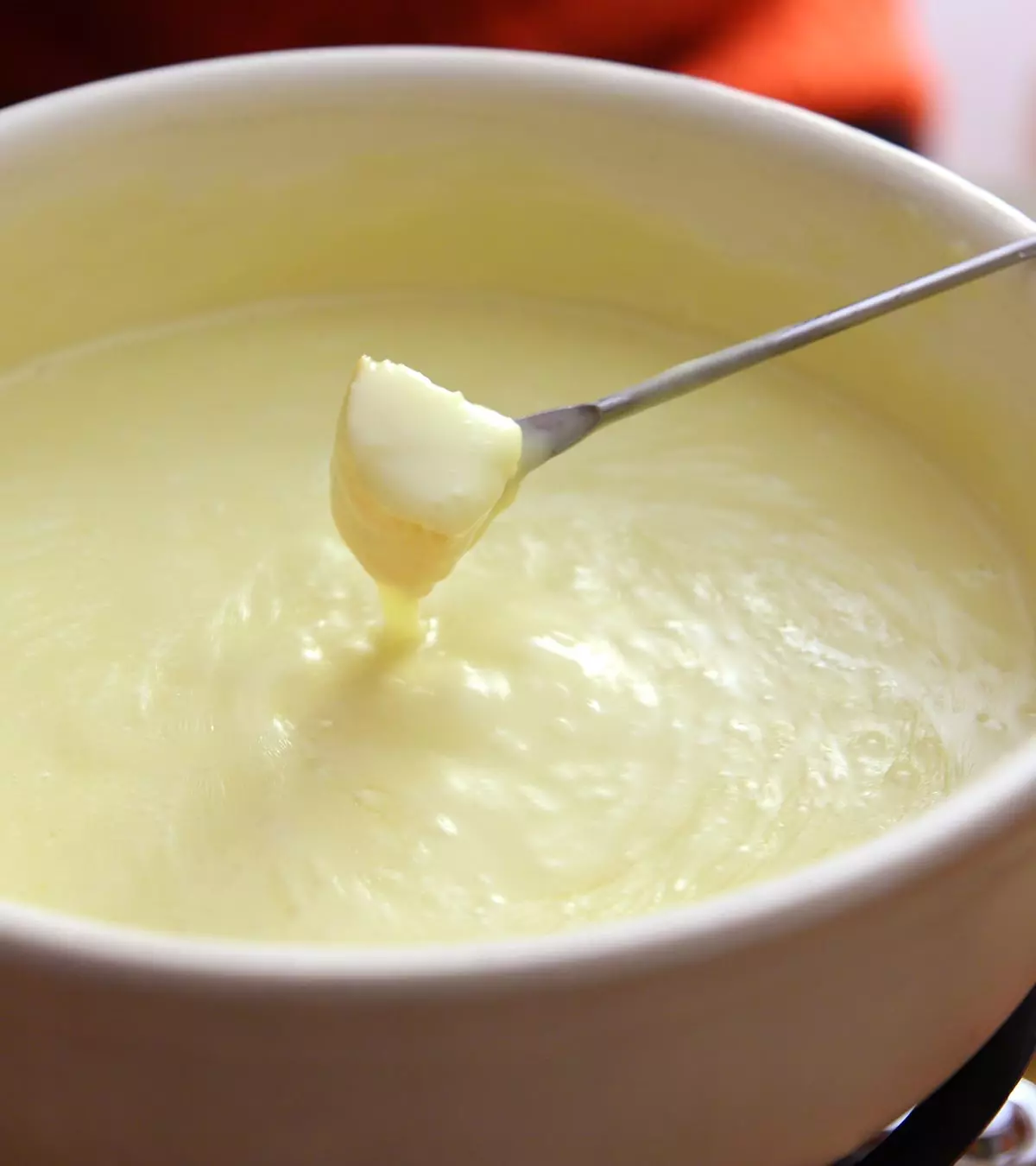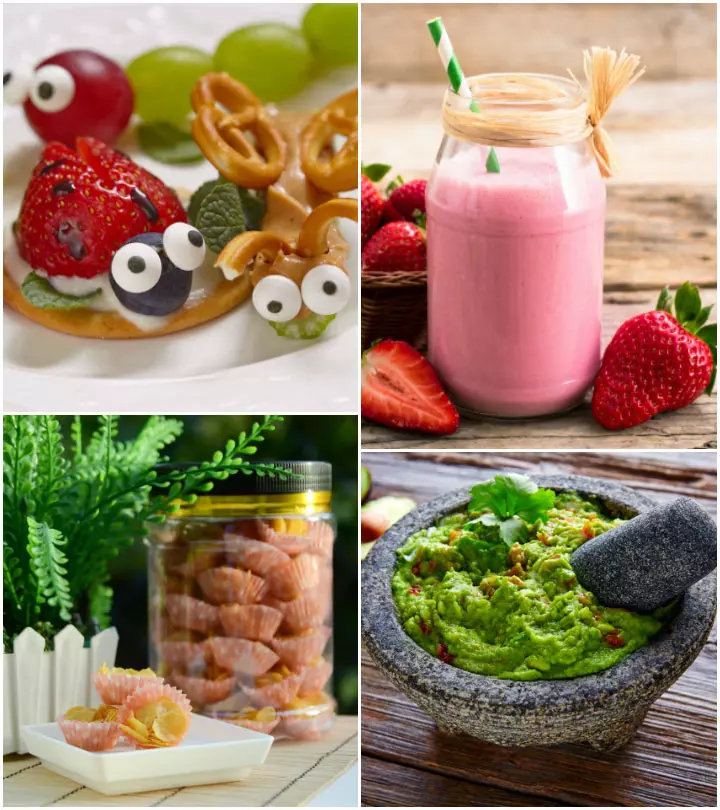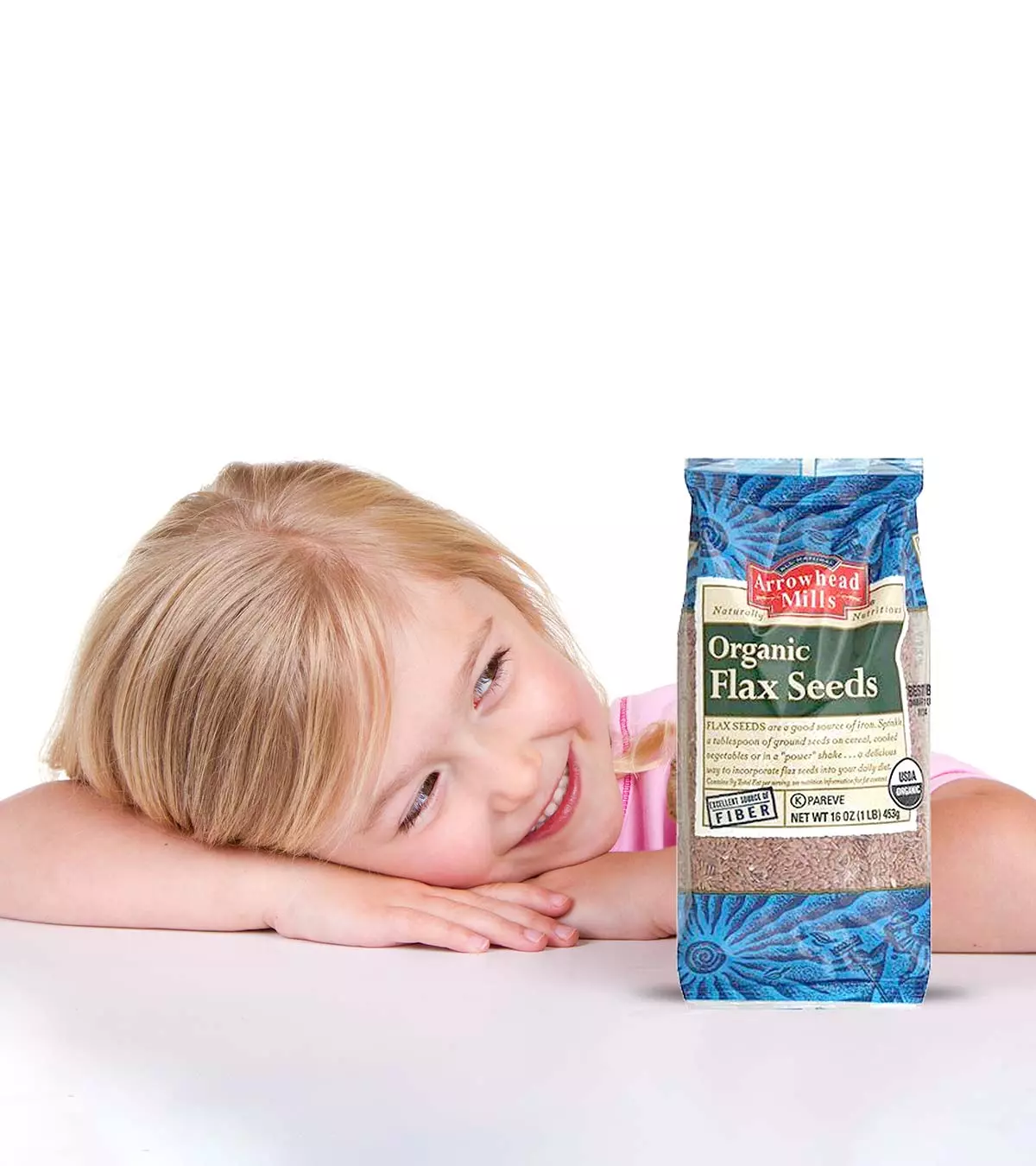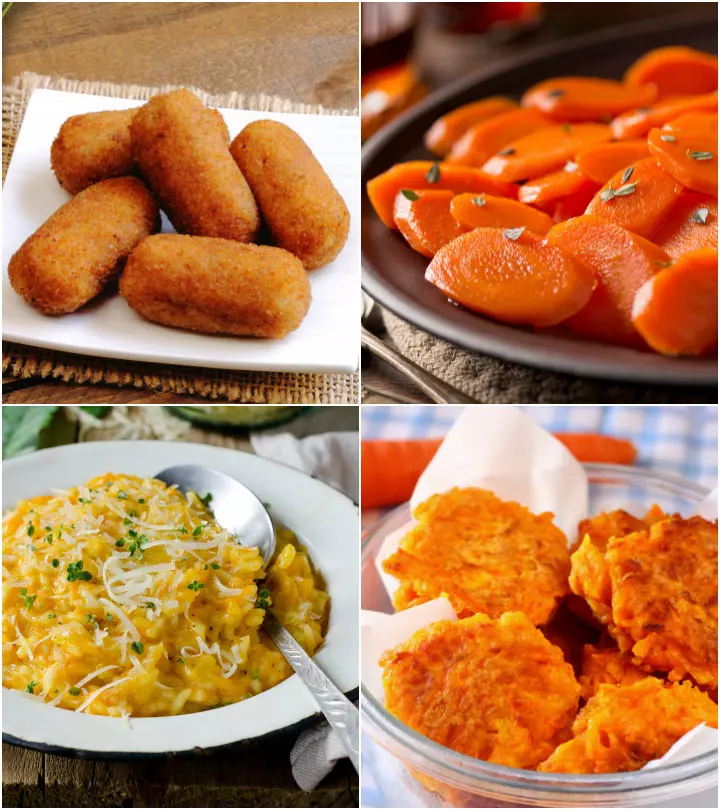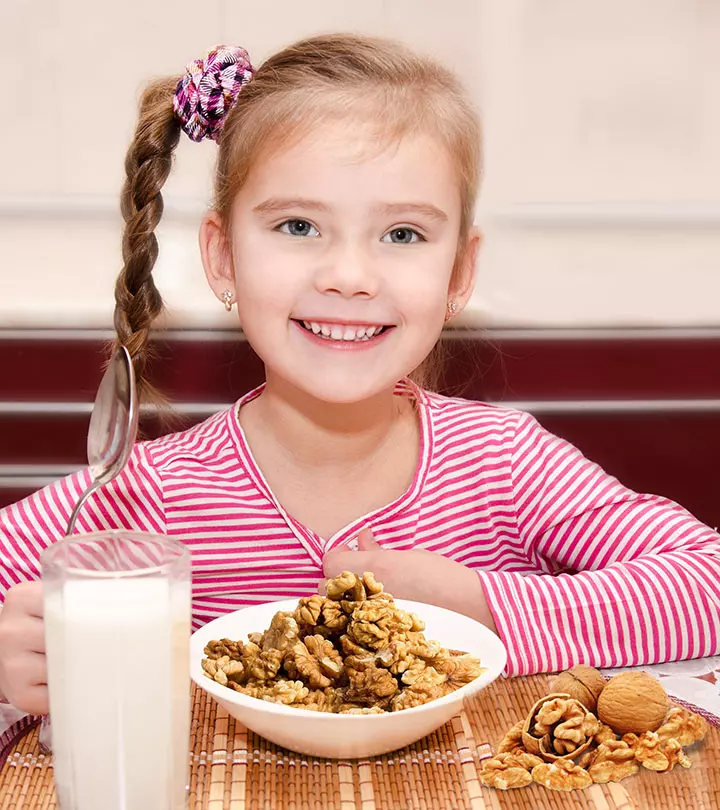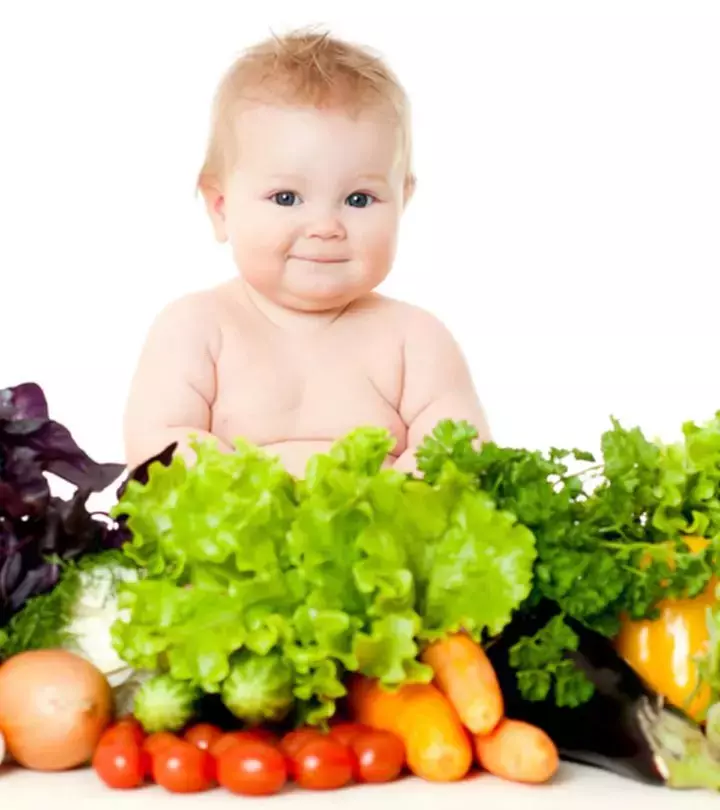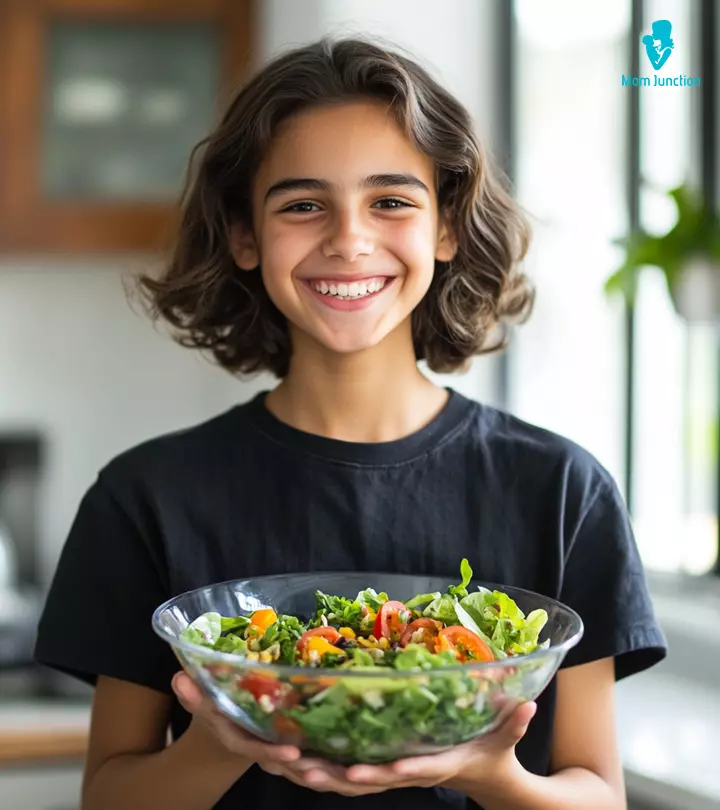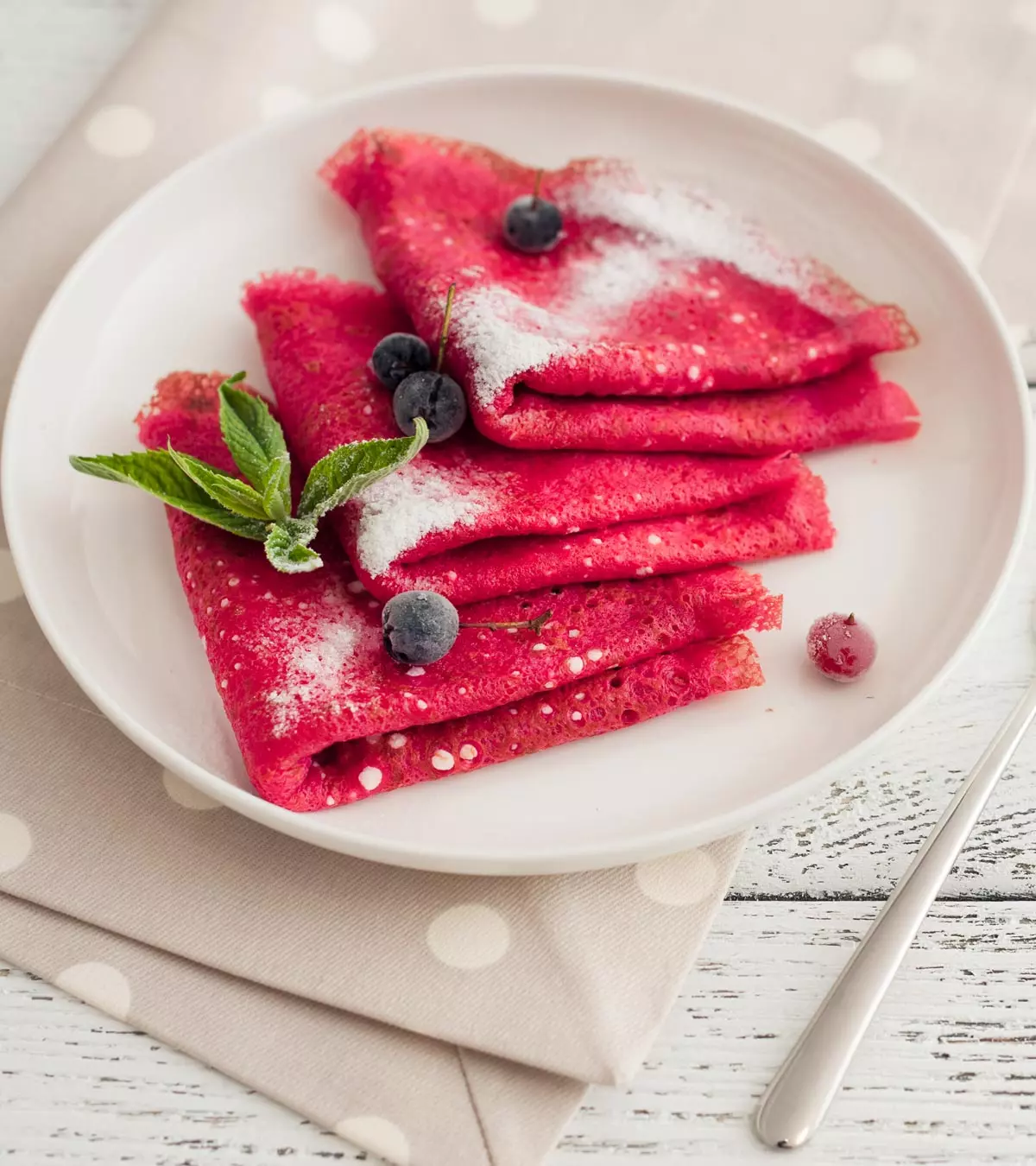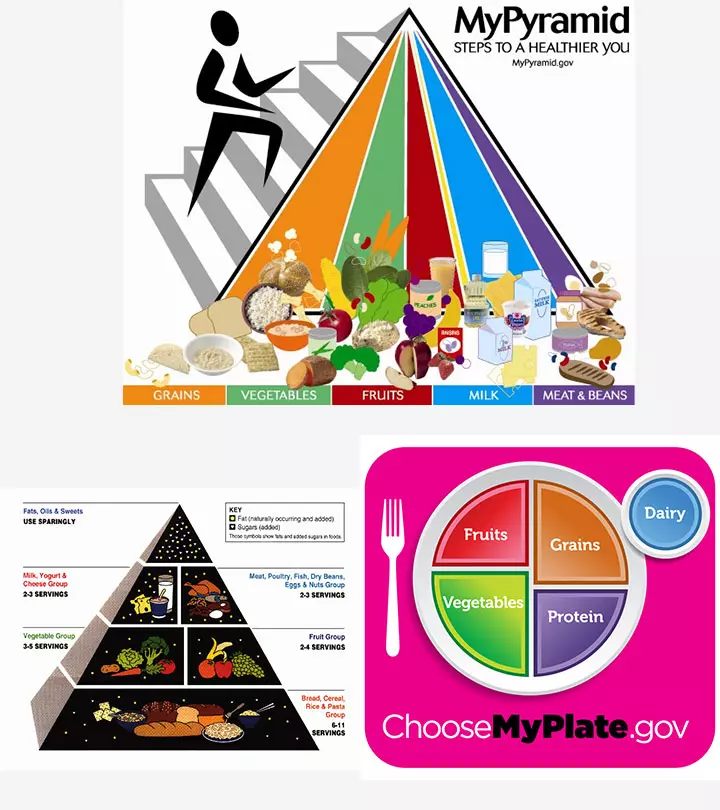
Image: MomJunction Design Team

The food pyramid for kids designed by the United States Department of Agriculture (USDA) is a reliable resource for parents, teachers, and caregivers. It guides them in helping children attain good health through a nutrient-rich diet and adequate activity.
The food pyramid, now called MyPlate, has been carefully divided into five food groups and contains extensive details on how much food children of each age group should consume daily to get complete nutrition. It also has illustrations of the food items that children should eat. Parents can use these pictures to encourage the habit of healthy eating.
Read the post to understand in detail the USDA food pyramid or MyPlate and follow the guidelines to ensure your children eat healthily.
Key Pointers
- The USDA created the Food Pyramid, now called MyPlate, to aid children in achieving good health through proper nutrition and activity.
- MyPlate creates personalized meal plans for children based on their age, gender, weight, height, and physical activity.
- The food guide educates adults on necessary foods for complete children’s nutrition and promotes a healthy lifestyle with a balanced diet and activity.
- MyPlate encourages children to consume a variety of healthy foods, including more whole grains and fruits, and less saturated fats.
- MyPlate divides food into five groups – grains, fruits, vegetables, proteins, and dairy – and outlines the daily amount of each group children should eat for optimal nutrition.
What Is A Food Pyramid?
For over a hundred years now, the US Department Of Agriculture (USDA) has been publishing a list of healthy foods that people should eat (1). Officially named the Food Guide Pyramid, it was designed to be a guide that encouraged people to build healthy eating habits. The guide had information about different types of foods and the right portions to be included in a daily meal.
- The USDA officially launched the Food Guide Pyramid in 1992, keeping in mind the American lifestyles and eating habits.
- Food Guide Pyramid was re-branded as MyPyramid in 2005. MyPyramid For Kids is a popular nutrition guide for parents and teachers across the US.
- In 2011, the USDA replaced MyPyramid with MyPlate, which comes with a checklist that can be personalized. The checklist considers the age, gender, weight, height and the amount of physical activity of the child to come up with a personalized meal plan (2).
What Is The Importance Of Food Pyramid For Kids?
The USDA food guide is one of the most popular food guides that you can rely on. The food pyramid was developed after extensive research, keeping in mind the individual dietary habits and lifestyles. This food pyramid also helps children develop a healthy way of life, with equal emphasis on diet and activity. It serves as a crucial educational tool that helps children and their parents make informed nutritional decisions, fostering lifelong healthy eating habits.
An Exhaustive Guide For Caregivers
Caregivers may not always know what foods are good and what are bad for the kids. They may also not be aware of the nutrition information for a particular fruit, vegetable, dairy product or meat. The food guide is comprehensive and provides parents, teachers, and other caregivers with the necessary nutrition education so they are aware of the types of foods they must include in a child’s diet. With the help of the MyPlate guide, you can develop a personalized diet plan that meets the daily nutrition requirements of your child.
Build Healthy Habits In Kids
The colorful MyPlate logo is self-explanatory with images of fruits, vegetables, dairy and meat that kids should eat. Parents can use the images and activities on the MyPlate site to introduce healthy foods for kids to children and teens and keep them away from junk foods. Teachers can also use the food pyramid to introduce the idea of nutrition and healthy eating in school.
 Quick fact
Quick factHow Many Food Groups Are There In The Food Pyramid?
The food pyramid is an easy tool to build healthy eating habits for your kids. The USDA Food Guide Pyramid and the MyPyramid had six food groups. However, the latest food guide, MyPlate, has five. Here is a note on what the main food groups in the food pyramid and MyPlate are.
1. Grains
Foods made of grains like rice, wheat, millets, corn, muesli, quinoa, rye, barley and oats fall under this category. Examples of grain foods include whole-wheat bread or pasta, brown rice, cornbread, popcorn, and cooked cereal, among others. Some cereals are also rich in omega-3 fats.
- More than half of the grain-based foods that you include in your kid’s meal should be whole grain foods. Replace white flour-based foods with whole-wheat foods to ensure that your child gets maximum nutrition.
- Whole wheat flour is rich in fiber and vitamins B-1, B-3, B-5, riboflaviniVitamin B2, mainly found in meat and dairy products, produces coenzymes and helps in the breakdown of fats to produce energy. , and folateiNaturally occurring form of Vitamin B9, responsible for protein metabolism and the production of red blood cells. . By replacing white flour foods with whole grain foods, you also reduce the risk of diseases. (3)
- If your kids are used to eating refined grain foods like white rice, cornmeal, and white bread, getting them to eat whole wheat foods can be difficult.
- Do not switch from refined grain to whole grain overnight. Instead, introduce whole-grain products in small portions and gradually replace all refined foods with whole-grain foods. The amount of grain-based foods that your child should eat every day depends on the age and gender. (4)
| AGE GROUP | DAILY RECOMMENDATION* | DAILY MINIMUM AMOUNT OF WHOLE GRAINS | |
|---|---|---|---|
| Children | 2-3 years old 4-8 years old | 3 ounce equivalents 5 ounce equivalents | 1 ½ ounce equivalents 2 ½ ounce equivalents |
| Girls | 9-13 years old 14-18 years old | 5 ounce equivalents 6 ounce equivalents | 3 ounce equivalents 3 ounce equivalents |
| Boys | 9-13 years old 14-18 years old | 6 ounce equivalents 8 ounce equivalents | 3 ounce equivalents 4 ounce equivalents |
2. Fruits
According to the 2025 National Survey of Children’s Health (NSCH) data, approximately one-third of children aged between one and five years did not eat fruits daily. Ideally, one-quarter of your child’s daily meal should consist of fruits like apples, bananas, and oranges.
- Fruits are rich in vitamins, minerals, and other nutrients that your child needs for growth. They are the best sources of vitamin C that protects against cardiovascular diseases and eye diseases; folic acid that plays a major role in preventing cancer (5); potassium provides enhanced muscle strength and improved metabolism; and fiber keeps your cholesterol in check.
- Research has proven that people who include fruit in their regular diet are less susceptible to heart diseases, cancers of the mouth, lung, larynx, pancreas, cervix, and esophagus (6) among others. Fruits are also known to reduce the risk of certain cancers, diabetes, and heart problems (7).
- Fruits rich in potassium also reduce the risk of blood pressure and prevent the development of kidney stones.
- More than anything, fruits have low-fat content and fewer calories, so you can keep snacking more fruit without worrying about gaining weight. Fruits are also among the recommended first solid foods for babies (8).
Your child may or may not develop a liking for eating fruits. Here are a few ways to get your kids to eat fruits from an early age. - Always have fruits at home. Have a bowl of fresh fruits on the table – ensure that you include seasonal fruits in it.
- Introduce a variety of fruits, including melons, citrus fruits, and berries as healthy snacks for teenagers and kids early on.
- Make sure that there is a lot of color in your fruit bowl. Include orange and yellow fruits like mangoes, oranges, grapefruit, pears, peaches, red fruits like cherries, apples, and pomegranates, green fruits like green apples, papaya, watermelon, kiwifruit alongside blue and purple colored fruits like blueberries, plums, and prunes. Fruits like watermelon and strawberries also increase our water intake.
- If your child refuses to eat cut fruit, try fruit juices. Stick to 100% fruit juices. You can also opt for fruit-flavored smoothies or other forms of beverages but avoid adding sugar, cream, or other flavoring agents which could adversely affect your child’s health.
| AGE GROUP | DAILY RECOMMENDATION* | |
|---|---|---|
| Children | 2-3 years old 4-8 years old | 1 cup 1 to 1 ½ cups |
| Girls | 9-13 years old 14-18 years old | 1 ½ cups 1 ½ cups |
| Boys | 9-13 years old 14-18 years old | 1 ½ cups 2 cups |
 Quick fact
Quick fact3. Vegetables
Like fruits, vegetables are rich in essential nutrients and low in carbohydrates and fat. They can be eaten raw, cooked, or semi-cooked, depending on how your kid likes them. You can buy fresh vegetables or frozen/dried vegetables.
Whatever your choice is, make sure that vegetables are a part of your kid’s daily food intake.
Vegetables can be classified into five different groups, based on their nutrient content.
Starchy: Veggies like cassava, corn, fresh cowpeas, field peas or black-eyed peas (not dry), green banana, green peas, green lima beans, plantains, taro, water chestnuts, and white potatoes are a few examples. These vegetables are rich in fiber, minerals and vitamins.
Dark Greens: Bok choy, broccoli, collard greens, dark green leafy lettuce, kale, mesclun, mustard green, romaine, spinach, turnip greens and watercress are a few to mention. They are rich in Vitamin A and act as cleansers that flush out toxins from your body.
Red and orange: Acorn squash, butternut squash, carrots, hubbard squash, pumpkin, sweet potato, red chili peppers, and tomatoes are all a part of the red and orange vegetable group. These vegetables have a high content of beta-caroteneiNatural dyes in plants get converted into Vitamin A upon ingestion by humans. , magnesium, calcium and vitamin C. Nutrients from these vegetables can help you fight free radicals in the body and reduce the risk of prostate cancer and joint pains.
Beans and peas: They are matured versions of lentils and legumes. The different types of beans you can have in your meals are kidney beans, soy beans, Lima beans, black peas, garbanzo beans or chickpeas and pinto beans. Beans come in different shapes, sizes, and colors and are as rich in nutrients as meat and poultry and often replace them (9). They are free of cholesterol but rich in potassium, plant protein, iron, and zinc.
Other vegetables that you should include in your kid’s diet are artichokes, parsnips, green beans, Brussels sprouts, onions, cabbage, asparagus, eggplant, green peppers, avocado, cauliflower, cucumbers, iceberg lettuce, bean sprouts, turnips, mushrooms, beets, wax beans, okra, and zucchini.
You may not be able to include all these veggies in a single day’s meal. But you can include at least two or three different varieties of veggies in your kid’s meal every day.
That said, getting your child to eat his veggies is one of the most difficult things to do, but not eating vegetables is not an option! Why not leave the old school ways and try something new?
- Try to make a dish that contains different vegetables (preferably of different colors), so that your kid gets the nutrition he needs.
- Mash up veggies or create vegetable pastes or purees that can be used in some dishes. Try to make fresh purees, rather than using processed or refrigerated ones.
- Stir fry vegetables to make them crunchy and tasty, but avoid deep frying or using fatty oils.
- Let your children pick one vegetable that goes into the salad, or that should be eaten during dinner. Older children can also help you peel, cut, and serve veggies at the table.
| DAILY VEGETABLE TABLE | ||
|---|---|---|
| Recommended Intake | ||
| Children | 2-3 years old 4-8 years old | 1 cup 1 ½ cups |
| Girls | 9-13 years old 14-18 years old | 2 cups 2 ½ cups |
| Boys | 9-13 years old 14-18 years old | 2 ½ cups 3 cups |
4. Protein Foods
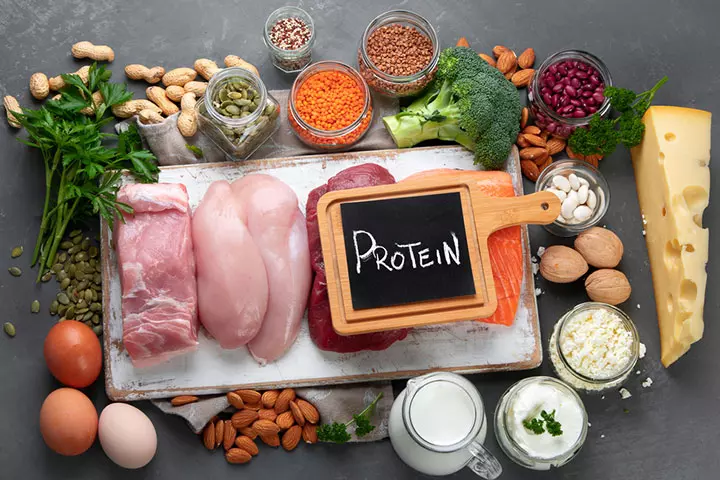
Image: Shutterstock
Protein, a major macronutrient, is the source of energy to our body. It helps form the blocks of body tissue.
Meat, poultry, fish, and nuts are the most common foods that supply protein to the body. Beans and peas, along with processed soy products, are also rich sources of protein.
- A protein diet usually consists of a variety of meat products like chicken, beef, pork, and lamb.
- Care should be taken while choosing foods from this group as some meats contain high amounts of saturated fat and cholesterol, which can increase the risk of heart disease.
- Avoid cooking red meats like beef, pork, and lamb, which have high amounts of saturated fat. Instead, opt for lean meats like chicken and fish (10).
- Egg (whole) is a good source of protein, but you can choose to eat only the yolk or the white (which is free of cholesterol) depending on your needs.
- For vegetarians, beans and peas, nuts, and soy products like tofu and soy sauce are the major sources of protein (11). Vegetarian products rich in proteins include beans (all types), cottage cheese (tofu or tempeh for vegans), peanut butter (high in calories), soy products (milk, yogurt, and cheese), and unpolished or brown rice.
Remember:
- Choose lean meat options like lean ground beef (with less than 8% fat), boneless chicken, or turkey cuts. You can even take off the skin before you cook the meat to lessen the fat content.
- Vary your protein options – replace meat with seafood and plant-based proteins two or more days a week.
- Seafood is a low-calorie protein source. Opt for cod, mackerel, salmon, and herring which have high protein content but less than 200 calories, especially if you want to keep your kid off fatty foods.
- Avoid giving your kids deep fried meats that contain a high amount of saturated fats, and can add to unwanted weight gain.
| DAILY PROTEIN FOODS TABLE | ||
|---|---|---|
| DAILY RECOMMENDATION* | ||
| Children | 2-3 years old 4-8 years old | 2 ounce equivalents 4 ounce equivalents |
| Girls | 9-13 years old 14-18 years old | 5 ounce equivalents 5 ounce equivalents |
| Boys | 9-13 years old 14-18 years old | 5 ounce equivalents 6 ½ ounce equivalents |
5. Dairy
All liquid and solid food products that are derived from animal milk fall under this group. Milk, yogurt, and cheese are the most popular forms of dairy products that you can find today.
- Dairy products are rich in Vitamin D, calcium, potassium, and protein.
- Primarily, milk products that retain their calcium content fall in this group. So cheese, butter, and cream, which have little or no calcium, are not considered as dairy in the food pyramid.
- That said, fortified soy milk and other plant-based products with calcium also fall under the dairy food group.
- Dairy products are rich in calcium, which helps strengthen the bones and teeth.
- Rich source of calcium, dairy products help in strengthening bones and teeth. Regular intake of dairy products also reduces the risk of osteoporosisiA condition that weakens bones, increasing the chance of sudden, unsuspected bone fractures. , a condition that weakens your bones and makes them brittle.
- Dairy is also known to lower blood pressure and reduce the risk of cardiovascular diseases and type 2 diabetes.
Remember:
- Consider milk and cereal as a breakfast option.
- Use products like cheese in your dishes.
- Make smoothies which have the goodness of dairy as well as fruits.
- Make dips with yogurt or cheese to go with snacks and vegetables.
- Make desserts with low-fat milk or cream.
| DAILY DAIRY TABLE | ||
|---|---|---|
| DAILY RECOMMENDATION | ||
| Children | 2-3 years old 4-8 years old | 2 cups 2 ½ cups |
| Girls | 9-13 years old 14-18 years old | 3 cups 3 cups |
| Boys | 9-13 years old 14-18 years old | 3 cups 3 cups |
How Is MyPlate Different From Food Pyramid?
The Food Pyramid had a food group called “sweets and fat oils”, which included cookies, doughnuts, cakes, soda pop, and other sugar treats. These products have a lot of empty calories but provide little nutrition to your kids.
MyPlate eliminates this food group completely. MyPlate also differs from MyPyramid in the following aspects.
1. Portions
- The Food Guide Pyramid and the MyPyramid focused on two things – what and how much to eat every day.
- The pyramid had clear specifications about the number of servings of different food types in the pyramid for calorie counting. For example, it clearly stated that toddlers aged between two and six years of age should eat six servings of grain food, two servings each of fruits, dairy and meat, and three servings of vegetables.
- But it was generic and did not consider factors like the child’s age, weight, height, or gender.
- The food plate divides the five main food groups into equal slices and provides the amount of physical activity a kid should get every day. This allows you to get the desired results sooner, while reducing the risks of overeating, or undernourishment.
 Point to consider
Point to consider2. MyPlate Is Easy To Understand
- The 2005 MyPyramid food guide was colorful but had little information. It was different from the previous one.
- MyPyramid had longitudinal sections that indicated each food group but with no labels, which made understanding MyPyramid For Kids a difficult task. You had to have a computer to know what each color denoted.
- MyPlate is simpler that way. The logo is clear and simple to understand with labels of the food groups mentioned on it.
- While you would need a computer to know about each food group in detail, you would at least know what types of food you should include in your meal plan by looking at the logo.
- The best part about the plate is that it is teachable and easy to understand because of the shape of the image. People understand better when you show them the MyPlate logo and say “your food plate should look like this,” than when you show the pyramid.
3. For Toddlers, Preteens and Teens
The Pyramid Food Guide and MyPyramid that the USDA designed in 1992 and 2005 were generalized when it came to the amount of food recommended. MyPlate requires you to put in specifics about your child like his weight, height, and the amount of physical activity he gets before recommending how much to eat.
While both the pyramid and the plate give healthy eating advice for adults and kids aged two years or above, the pyramid lacked age-specific recommendations. MyPyramid had one diet plan for kids aged between two and six. Teenagers and preteens had the same recommendation as adults did, which wasn’t very helpful. MyPlate gives specific portion control recommendations for different age groups:
- Toddlers (2-3 years old)
- Children aged 4-8 years
- Girls aged 9-13 years and 14 to 18 years
- Boys aged 9-13 years and 14 to 18 years
The pyramid does not cover one-year-old kids, unlike the MyPlate. MyPlate also recommends specific food portion sizes for men and women separately, based on the age group they fall under. Adults are categorized into three age groups:
19-30 years
31-50 years
51+ years
The portion sizes are also explained in detail on the MyPlate website so that you know how much food amounts to take in one serving. Again, this prevents overeating or undernourishment.
4. Physical Activity

Image: Shutterstock
Both MyPyramid and MyPlate recommend physical activity. However, MyPyramid did not consider a person’s physical activity levels in a day to determine portion sizes. The new food guide has a page dedicated to physical activity and its importance. The ChooseMyPlate.gov website gives you detailed information about the different types of physical activities and how many calories they help you burn in an hour, based on which it tells you how much to eat.
Food Pyramid Games And Activities
The MyPlate website has a dedicated section for physical activity, which has information about walking, hiking, running, cycling, swimming and other outdoor activities your kids can indulge in. Children and teens should be encouraged to participate in physical activities at school and at home. While it is okay to play video games, it should be in moderation. Let your children play outdoors more often, to ensure that they are getting enough exercise every day.
The USDA has also introduced a Super Tracker to keep a track of your daily physical activities (12). The tracker gives you a daily report of how many calories you have burned on a day.
The Balancing Act
The key to a healthy life is to know how to balance the food you eat and the number of calories you burn every day. The food pyramid or plate only tells you what to eat and how much to eat. It is up to you to follow the recommendations.
If you have never really followed a food pyramid diet regime for yourself or your kids, it may be difficult to switch to the MyPlate plan overnight.
So start slow and introduce food types from the pyramid for your children one at a time. It is equally important to ensure that your kids eat foods from each of the five groups every day, for complete nourishment.
However, if your child is averse to dairy products or is lactose intolerant, you can consider other sources of calcium like soy milk, fruit juices, almond milk, cereals, soybeans, and leafy greens, and canned fish like sardines and salmon.
Milk products should be consumed in moderation, to prevent unnecessary accumulation of calories. Also, it is best to avoid raw milk or milk products made from unpasteurized (raw) milk.

Click here to view an enlarged version of this infographic
Frequently Asked Questions
1. What is the basic food pyramid?
The first food pyramid was presented in 1974, and it included three parts (13): The base consisted of foods such as pasta, potatoes, cereals, and dairy products, the middle consisted of fruits and vegetables for kids, and the top consisted of meat, fish, and eggs.
- The base consisted of foods such as pasta, potatoes, cereals, and dairy products
- The middle consisted of fruits and vegetables
- The top consisted of meat, fish, and eggs
2. What is the most important part of the food pyramid?
The base shelf of the food pyramid consists of all the most essential nutrient sources that should be eaten often (14).
3. Why is the food pyramid a triangle?
The food pyramid is a visual representation in a triangle shape to show the proportions of different types of food to include in a healthy diet. The pyramid is arranged in an order, with the most nutritious and healthy foods at the triangle’s base and less healthy options at the top (1).
The food pyramid for kids informs parents about the right kind of food and activity their children need to stay fit. This pyramid has been developed after deep research and analysis and encourages children to maintain a healthier lifestyle. As a parent, you can study the food pyramid in detail and understand how different foods benefit in different ways. Make sure to add foods from all the groups in your child’s diet as per their age. If your child is allergic to dairy or lactose intolerant, add alternatives such as soy milk, almond milk, and green leafy vegetables. Remember to maintain a balance between food and activities to get optimum benefits.
Infographic: Implementing The Food Pyramid
The Food Pyramid and MyPlate are visual representations of a healthy and balanced diet. Fortunately, balancing food proportions with the above guidelines need not be restricted to dinner time anymore with these guidelines. Scroll down to find an infographic that provides a few tips for packing a healthy lunch box for children and teens. Illustration: Momjunction Design Team
Illustration: What Is The Importance Of Food Pyramid For Kids And Teens?
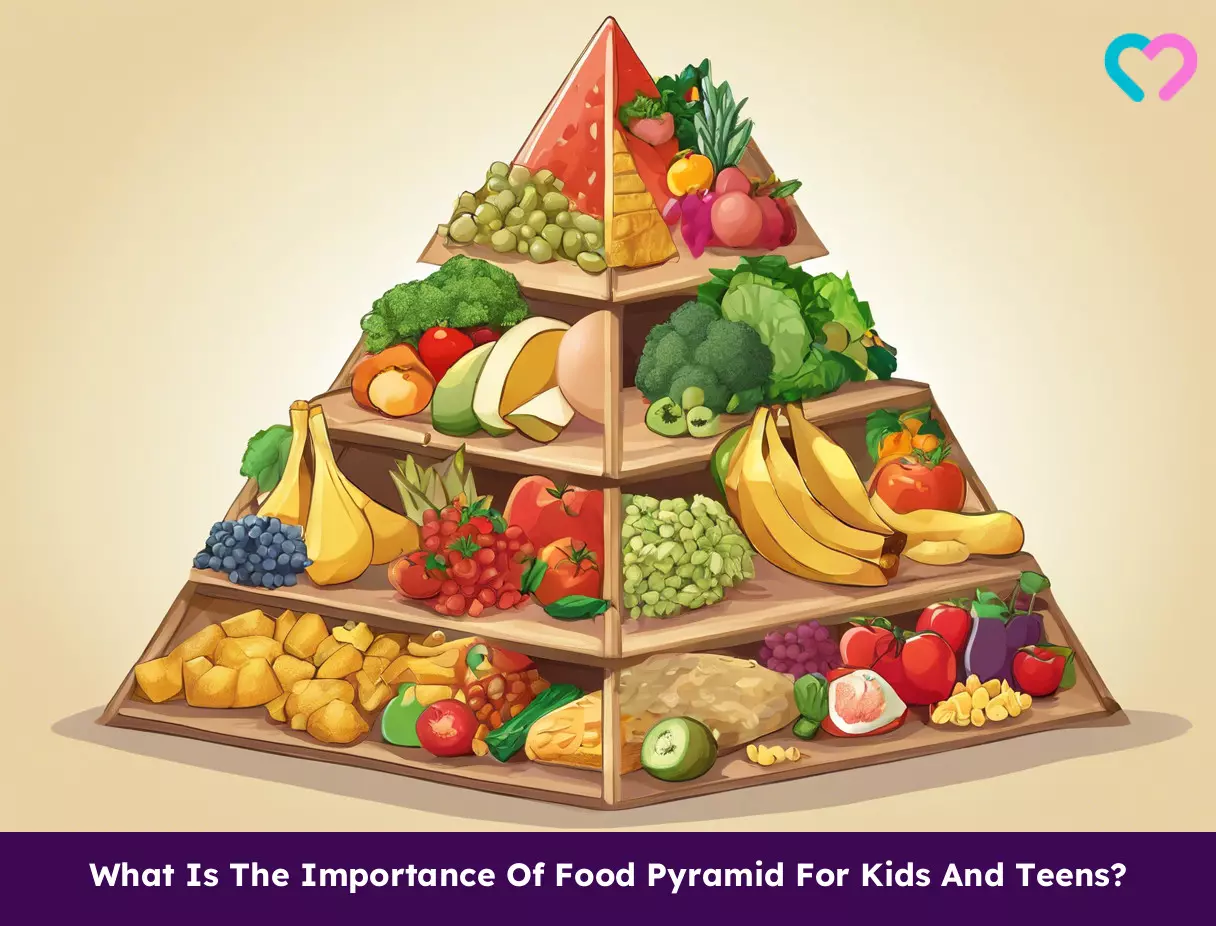
Image: Stable Diffusion/MomJunction Design Team
Learn how to properly nourish your children by using the food pyramid! Learn how to promote a healthy diet for children and ensure they get enough nutrients.
References
- Healthy Eating Pyramid.
https://nutritionsource.hsph.harvard.edu/healthy-eating-pyramid/ - MyPlate daily checklist.
https://www.choosemyplate.gov/MyPlate-Daily-Checklist-input - Whole Grains.
https://nutritionsource.hsph.harvard.edu/what-should-you-eat/whole-grains/ - Grains.
https://www.choosemyplate.gov/grains - S J Duthie; (1999); Folic acid deficiency and cancer: mechanisms of DNA instability.
https://pubmed.ncbi.nlm.nih.gov/10746348/ - K. A. Steinmetz and J. D. Potter; (1991); Vegetables fruit and cancer. I. Epidemiology.
https://pubmed.ncbi.nlm.nih.gov/1834240/ - Fruit and vegetables.
https://www.betterhealth.vic.gov.au/health/healthyliving/fruit-and-vegetables - Starting solids.
https://llli.org/breastfeeding-info/starting-solids/ - Vegetables beans and peas.
https://www.choosemyplate.gov/vegetables-beans-and-peas - Picking Healthy Proteins.
https://www.heart.org/en/healthy-living/healthy-eating/eat-smart/nutrition-basics/picking-healthy-proteins - What are vegetarian and vegan choices in the protein foods group?
https://ask.usda.gov/s/article/What-are-vegetarian-and-vegan-choices-in-the-Protein-Foods-Group#:~:text=Protein%20sources%20from%20the%20protein,such%20as%20tofu%20and%20tempeh. - USDA’s SuperTracker Diet Planning and Tracking Tool Reaches One Million Registered Users.
https://www.usda.gov/media/press-releases/2012/09/06/usdas-supertracker-diet-planning-and-tracking-tool-reaches-one#:~:text=SuperTracker%20is%20a%20resource%20to,their%20risk%20of%20chronic%20disease. - Origins of the food pyramids.
https://www.alimentarium.org/en/fact-sheet/origins-food-pyramid - The food pyramid.
https://www.gov.ie/en/publication/70a2e4-the-food-pyramid/#:~:text=The%20Food%20Pyramid%20allows%20individualsto%207%20servings%20a%20day). - MyPlate Food Guide.
https://kidshealth.org/en/kids/pyramid.html - Fruit Juice in Infants, Children, and Adolescents: Current Recommendations.
https://www.vdh.virginia.gov/content/uploads/sites/30/2018/01/AAP_Fruit_Juice_Recommendations_Excerpts_kap_2017.pdf - Take Charge of Your Health: A Guide for Teenagers.
https://www.niddk.nih.gov/health-information/weight-management/take-charge-health-guide-teenagers
Community Experiences
Join the conversation and become a part of our nurturing community! Share your stories, experiences, and insights to connect with fellow parents.
Read full bio of Dt. Pallavi Jassal
Read full bio of Swati Patwal
Read full bio of Rohit Garoo
Read full bio of Shinta Liz Sunny





